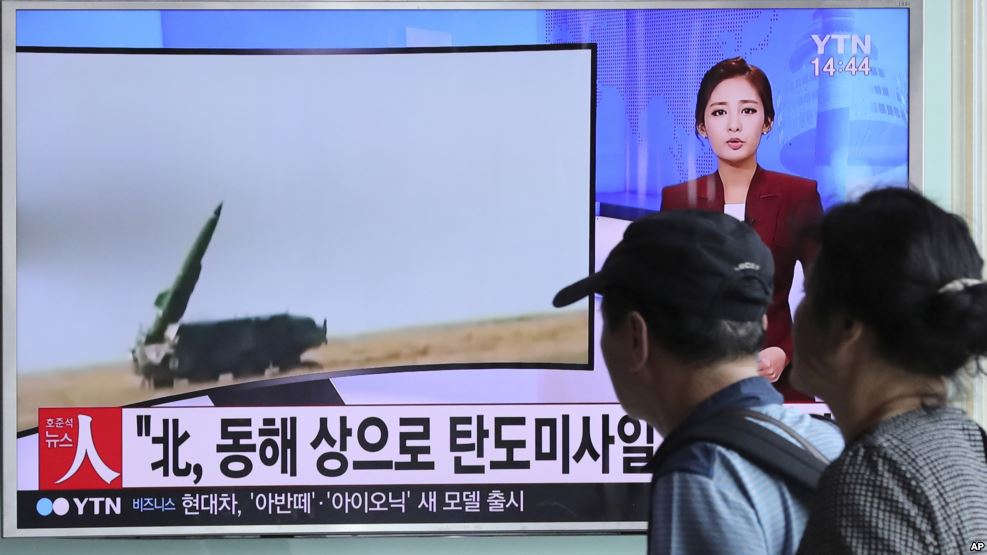North Korea fired three medium-range missiles that landed in Japan’s exclusive economic zone Monday. South Korea reported the missiles were launched from Hwangju in North Hwanghae Province at around 12:14 p.m. local time, hours after the Group of 20 economic summits in China discussed Pyongyang’s threats.
Monday’s launches are the latest in a series of more than ten ballistic tests that North Korea has conducted during 2016 despite U.N. sanctions. Pyongyang’s actions are troubling relations in the Asian continent. The missiles have been identified by South Korea’s Joint Chiefs of Staff as Rodong missiles, which have a range of one thousand kilometers, about six hundred miles. Japan’s Defense Minister Tomomi Inada stated all three missiles fell off the northwestern coast of Hokkaido. He added they were launched almost simultaneously and fell around the same spot of the Japanese exclusive economic zone.

The Minister showed concern because North Korea’s demonstration proves it has been improving its missile technology. Tokyo’s Defense Ministry explains Japan’s exclusive economic zone is a 200-nautical mile offshore area where the nation has sovereign rights for exploring and exploiting resources.
A U.S. official who attended the G20 summit condemned North Korea’s actions for being a threat to both aircraft and maritime vessel operating in the zone. Japanese Chief Cabinet Secretary Yoshihide Suga considers the launches a serious threat to the country’s security. Tokyo has protested to North Korea via the Japanese Embassy in Beijing, CBS 8 reported.
North Korea’s missile tests are part of a plan that wants to be capable of striking the United States.These efforts would eventually lead to building long-range nuclear missiles capable of reaching the North American country. The countries most affected by Pyongyang’s military tests are China, North Korea’s only major ally, and South Korea.
South Korea fears a missile attack, China fears being spied
South Korean President Park Geun-hye told Chinese President Xi Jinping that North Korea’s behavior this year has undermined peace in the region and poses a challenge to the development of relations between the two nations. In contrast, China says mishandling the recent missile launches affects stability in the region and could intensify disputes, referring to the new anti-missile system installed in South Korea by the United States.

However, Park Geun-hye admitted the U.S. THAAD, Terminal High Altitude Area Defense, was an “inevitable, self-defense.” Still, China fears the system is spying its military capabilities and other Chinese interests. Russia is also concerned about China being spied by the U.S.
North Korea has a negative opinion about South Korea anti-missile system and has threatened to attack its neighbor country and the U.S. base in Guam. This “justifies” North Korea’s military conducts during 2016, in defiance of U.N. Security Council sanctions reformed in March.
The U.S. State Department stated that Monday’s launch and previous launches violate multiple United Nations Security Council resolutions prohibiting the country from launching ballistic missiles. Spokesperson John Kirby said America would raise its concerns at the U.N. about the threat it posed to international security.
According to Japan’s Foreign Ministry, Japanese Prime Minister Shinzo Abe approached Park during a coffee break at the G-20 and agreed to cooperate closely.
Monday’s launches are the latest in a series of attacks
In early August, North Korea also fired Rodong missiles which traveled about 620 miles, the longest ever flight by that kind of missile. Last month as well, the Kim Jong-un regime launched a missile, this time from a North Korean submarine. The weapon flew about 310 miles.

Missiles fired from a submarine base are harder to detect before launch, than land-based missiles such as Rodongs. After a string of failures, North Korea managed to send an intermediate Musudan missile more than 870 miles high in June.
Source: CBS
